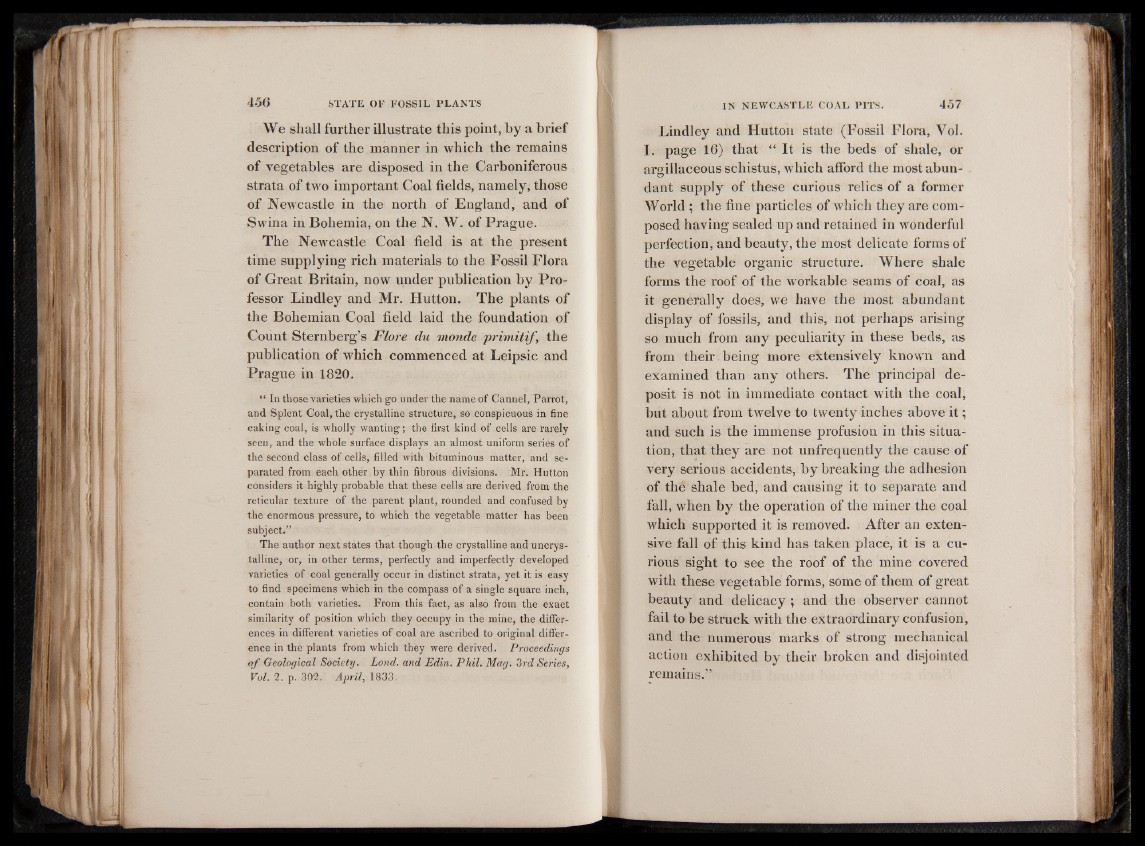
We shall further illustrate this point, by a brief
description of the manner in which the remains
of vegetables are disposed in the Carboniferous
strata of two important Coal fields, namely, those
of Newcastle in the north of England, and of
Swina in Bohemia, on the N. W. of Prague.
The Newcastle Coal field is at the present
time supplying rich materials to the Fossil Flora
o f Great Britain, now under publication by Professor
Lindley and Mr. Hutton. The plants o f
the Bohemian Coal field laid the foundation o f
Count Sternberg’s Flore du monde primitif, the
publication o f which commenced at Leipsic and
Pra gu e in 1820.
“ In those varieties which go under the name of Cannel, Parrot,
and Splent Coal, the crystalline structure, so conspicuous in fine
caking coal, is wholly wanting; the first kind of cells are rarely
seen, and the whole surface displays an almost uniform series of
the second class of cells, filled with bituminous matter, and separated
from each other by thin fibrous divisions. Mr. Hutton
considers it highly probable that these cells are derived from the
reticular texture of the parent plant, rounded and confused by
the enormous pressure, to which the vegetable matter has been
subject/’
The author next states that though the crystalline and uncrystalline,
or, in other terms, perfectly and imperfectly developed
varieties of coal generally occur in distinct strata, yet it is easy
to find specimens which in the compass of a single square inch,
contain both varieties. From this fact, as also from the exact
similarity of position which they occupy in the mine, the differences
in different varieties of coal are ascribed to original difference
in the plants from which they were derived. Proceedings
o f Geological Society. Land, and Edin. Phil. Mag. 3rd Series,
Vol. 2. p. 302. A p r il,1333.
Lindley and Hutton state (Fossil Flora, Vol.
I. page 16) that “ It is the beds of shale, or
argillaceous schistus, which afford the most abundant
supply of these curious relics of a former
World ; the fine particles of which they are composed
having sealed up and retained in wonderful
perfection, and beauty, the most delicate forms of
the vegetable organic structure. Where shale
forms the roof of the workable seams of coal, as
it generally does, we have the most abundant
display of fossils, and this, not perhaps arising
so much from any peculiarity in these beds, as
from their being more extensively known and
examined than any others. The principal deposit
is not in immediate contact with the coal,
but about from twelve to twenty inches above i t ;
and such is the immense profusion in this situation,
that they are not unfrequently the cause of
very serious accidents, by breaking the adhesion
of the shale bed, and causing it to separate and
fall, when by the operation of the miner the coal
which supported it is removed. After an extensive
fall of this kind has taken place, it is a curious
sight to see the roof of the mine covered
with these vegetable forms, some of them of great
beauty and delicacy ; and the observer cannot
fail to be struck with the extraordinary confusion,
and the numerous marks of strong mechanical
action exhibited by their broken and disjointed
remains.”